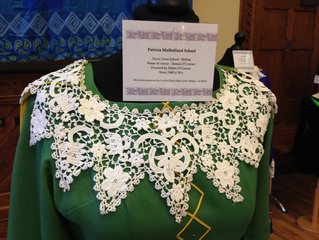 A dress from Leslie Baird's costume exhibition A dress from Leslie Baird's costume exhibition This week the sun was shining in Larne and the Orange Hall steps were ornate with dancers in emerald green, black, burgundy, royal blue, scarlet, navy blue and cerise. The festival was a positive experience made special by the charm of the dancers, the spirit of the musicians, the enthusiasm of the adjudicator, the generosity of visitors from across the province, the support from local people and the dedication of wee fairies who made it happen. There was also a strong sense of history. The lady at the door danced competitively in the same hall as far back as the 1930s, the pianist had danced as a toddler in a variety concert in Ballymena during the second world war, and the wee fairies on the stage and in the kitchen included grandmothers, mothers and daughters who have been dancing their whole lives. Few people realise is that Irish folk dancing, now primarily known as ‘festival dancing’ is a cross-community tradition. Even during the upheaval of ‘The Troubles,’ Catholics and Protestants continued to hold hands, literally and metaphorically, in towns like Belfast, Larne, Portadown, Ballymena, Ballymoney, Portstewart, Ballyclare and Bangor. Irish folk dancing, in fact, blossomed against the timbre of bullets and bombs. Catholics and Protestants in the Irish folk dancing tradition have been dancing together for for ninety years, but further back in time, the harvest homes, lintings, punch dances and Mayday festivities also provided opportunities for Catholics and Protestants to come together. Traditional Ulster social dances like ‘A Soldier’s Joy,’ ‘The Sweets of May’ and ‘The Three Tunes’ were danced by Protestants and Catholics before the term “Irish dancing” was invented.
3 Comments
|
ProseHistory & folkloreJean Park of Ballygally
Fiddles and Melodeons Martha Taylor's diary Jean McCullagh at 104 Ballymena & the McConnells Arms in Irish Dancing Catholics & Protestants in Irish dancing Dancing in Victorian Ulster Essays
|
 RSS Feed
RSS Feed